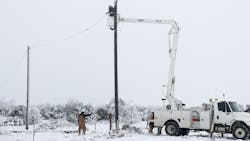How Digital Twins Can Make the Utility Industry More Resilient
When Winter Storm Uri swept across Texas earlier this year, temperatures in Dallas and elsewhere dropped below 0°, snow and ice made highways completely impassable, and even being indoors offered little relief. An unprecedented surge in electricity demand coupled with a frozen natural gas supply left millions of Texans without heat or water for days and forced utilities to initiate controlled blackouts across the state.
Power outages like these cost the U.S. economy US$70 billion annually, according to the U.S. Department of Energy (DOE). The four-day electricity crisis in Texas underscored the vulnerabilities in America's power grids that utility companies continue to contend with.
Whether through cyber risk, lost data, erroneous reports, or broken or malfunctioning equipment, the utility industry is vulnerable, and these vulnerabilities can affect consumers by the thousands. Some strides are being made across the nation to shore up utility infrastructure. The Biden administration's US$2.3 trillion infrastructure plan, for example, would modernize water systems, create workforce training programs, and make utilities eligible for more R&D funds.
Utilities' digital infrastructures
Broadly speaking, there's a long way to go. Experts from the American Society of Civil Engineers gave the nation's infrastructure a grade of C- in 2021 (which is actually better than the D+ the group handed out in the previous report card issued in 2017). Technology can play a key role in improving that grade.
While leading utilities have been upgrading their digital infrastructures for several years, the industry as a whole didn't begin pursuing digitalization aggressively until the pandemic hit. Now, it's in an all-out sprint as risk mitigation becomes one of the utility sector's chief priorities.
Risk mitigation, cost efficiency, and training are all receiving boosts from digitalization and, more specifically, digital twin technology. Digital twins, which serve as real-time digital visualizations of actual physical assets, can help utility companies not only improve operational efficiency and personnel training but also offer a way to stress-test important assets and systems in preparation for a wide range of scenarios like the outage seen in Texas.
To implement this digital twin technology effectively, though, utilities must strive to set higher standards for interoperability and good data management.
Why proper data management is essential
The utility industry is somewhat unique in that utilities' physical assets are often distributed across wide geographic regions. That said, big utility companies face many of the same obstacles to effective data management that other large organizations face. For starters, the sheer amount of data these companies collect is mind-boggling. The utilities have to track every megawatt of electricity and gallon of water that customers use in order to ensure that these resources are delivered effectively.
Utilities also generate lots of data from countless sources, as they rely on vast networks of disparate systems and applications to power core processes. Data from geographic information systems — a technology that is undergoing notable growth, thanks in part to demand from the utility industry — isn't always stored with data from IoT sensors, CAD software, and other applications. Instead, these technologies and their related data often exist in silos across the enterprise. This presents problems that digitalization can actually amplify.
According to a 2020 study by KPMG, 73% of utilities are planning to increase automation and 35% are looking to make new investments in cloud and on-premise infrastructure in the near future. That's great, but without improving existing architectures to achieve true interoperability, new technologies will just lead to more data and more silos.
But what happens if they do make those improvements?
Seeing what's possible
With an effective data management framework in place, data from all of these dispersed sources can be integrated into one model, allowing for real-time collaboration among multidisciplinary teams of virtually any size. For massive utilities, that presents major opportunities for cost savings and efficiency boosts.
When a model integrating data from BIM and CAD software, GIS platforms, IoT sensors, and other applications can be transformed into a real-time 3D visualization, even more opportunities open up. Right now, most utilities don't have the equipment needed to make digital twins accessible to lots of key stakeholders who could use them to drive decision-making.
Utilities can use technologies like WebGL to download data onto individual computers and view low-level 2D and 3D renderings of integrated models, but those visualizations aren't being rendered in real time. Plus, this approach introduces new threats to data security. Malicious actors could hack an employee's personal computer and steal valuable intellectual property or users could copy that data and mistakenly expose it in any number of ways.
The promise of digital twins
Well-functioning digital twins can correct this problem by allowing utilities to stream data from the cloud and visualize the utility's processes in real time. This type of digitalization means business leaders can access the data they need when they need it in a graphic format that allows for deeper insights than a traditional dashboard. And the cloud-based nature of this technology means utilities don't need to invest in expensive new hardware.
Beyond that, storing data in the cloud allows for the high levels of data security that make digital twin technology viable for energy companies, which rely on sophisticated analytics to drive decision-making.
Though it's easy to take electricity and other resources for granted in 21st century America, the reality is that delivering these resources effectively depends on a highly sophisticated system. The system works most of the time, but as the crisis in Texas shows, that's not always the case. By making use of digital twins, utilities can ensure they're ready for whatever tomorrow brings.
About the Author
Kevin Viggers
Kevin Viggers is a software architect at PureWeb, a company that makes interactive 3D a reality for all.
